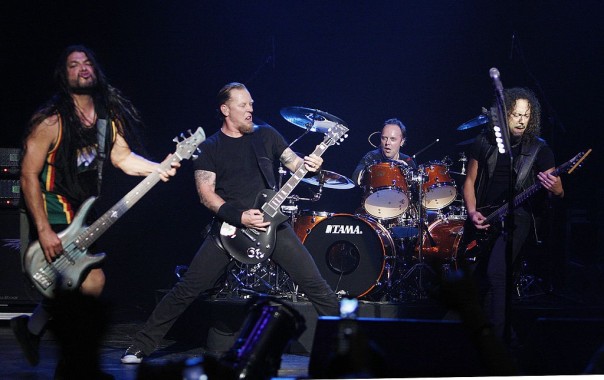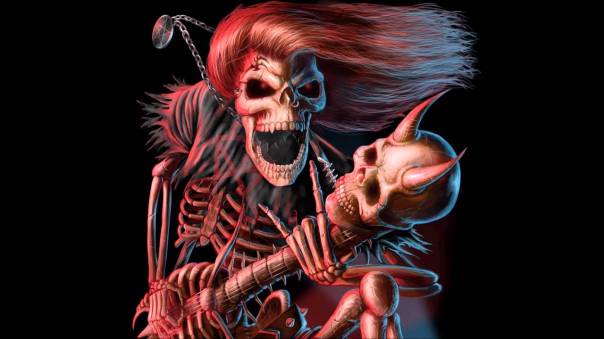Metalheads are a highly misunderstood group of people, mostly because very few people know as much about heavy metal as they think they do. For this reason, metal as a genre is not only unknown to most people, but villainized as well. The truth as metalheads see it is that it’s not just noise. It’s not always satanic and it doesn’t always involve sheep heads and blood. And it’s not any less sophisticated than pop or any other genre. Sadly, the average mainstream listener will probably assume all those things. So I’ll clear them up.
Note: videos may take a while to load, but they’ll show up eventually.
Classic Metal:
Metal dates back to the early 70s, when Black Sabbath’s self-titled album launched a new genre unlike anything the world had seen before. Along with Led Zeppelin and Deep Purple, they shaped classic metal out of classic hard rock, psychedelic rock, and hardcore punk, paving the way for the heavier subgenres to follow.
Hair metal (aka glam metal):
This light(ish) subgenre came from heavy hard rock more than it did from classic rock/hard rock rather than classic metal. It took pop-oriented melodies, and bashed them with distortion and aggressive keyboard leads. Bon Jovi, Ratt, Motley Crue, and Guns ‘n’ Roses were some of the most popular in the 80s, but the subgenre is close to extinct now.
Heavy Metal:
The term “heavy metal” is often used to refer to all metal in general, but the more specific subgenre is not as heavy as the name suggests. Iron Maiden and Judas Priest were the most notable bands, laying down the foundations for future subgenres of metal. Since it is often confused with metal as a whole, the term is not used and the subgenre goes by different names.
Progressive metal:
Note: video sounds best with stereo headphones. Progressive metal, or prog metal, was shaped from progressive rock and psychedelic rock, which were some of the more experimental genres of the 80s. It incorporated traditional metal sounds into keyboard-oriented arpeggios, unusual scales, and frequently changing, complex time signatures. Queensryche and Dream Theatre were some of the most successful prog metal bands, but some more influential bands, such as Metallica, had some prog metal songs even though it’s not their main genre.
Doom metal:
Doom had some of the original classic metal influences, but was characterized by slow beats and a thick, dissonant sound that can only be described as doom and gloom. Candlemass, Black Sabbath, and Lost Paradise are the most popular bands in doom. The most iconic doom metal hit of all time is easily Black Sabbath (by Black Sabbath, in the album Black Sabbath).
Thrash metal (aka speed metal):
And this is where it starts getting heavy. Bands like Metallica, Slayer, and Megadeth were on the frontlines shaping a whole new type of metal–one that can actually be considered heavy. Thrash is a fast, aggressive, ambitious genre with harsh distortion on the guitars and dark, brutal lyrics, but clean vocals, unlike death metal. Thrashcore (aka speedcore) is very similar to traditional thrash, just more dependent on the fast drums. Metallica was one of the most influential thrash band in the beginning, and Master of Puppets was and is still a classic.
Groove metal:
Bands like Pantera, Lamb of God, Machine Head added back some of the classic metal-like melodic groove into thrash, while still keeping it heavy. Some say it is an unnecessary style that metal could have done without. But Pantera undeniably shaped heavy metal as much as the next band, groove or not.
Metalcore:
If you like hoarse, tortured vocal screeching over drop A# guitars and sixteenth beat double kick drums, this one’s for you. Suicide Silence, Motionless in White, and Killswitch Engage reinvented “heavy” music with their scream/yell-singing. Unlike some other lighter genres, metalcore (formally hardcore heavy metal) retained it’s popularity well into the new millennium, leaving classic metal in the dust.
Death Metal (and brutal death):
Rather than screaming, true death metal not only incorporates but relies almost exclusively on equally hoarse but much deeper guttural growls for vocals. While it’s not always as heavy on the distortion as other genres, the brutal and distorted lyrics are what sets death metal apart from all the rest. Cannibal Corpse and Morbid Angel are the most well-known bands, and while there are many more, Cannibal Corpse was easily the most influential in the development and longevity of death metal.
Melodic Death Metal (aka melodeath):
Another type of death metal, melodic death, was developed to counter the already-established death metal bands that focused on distortion and weight rather than the actual music. It was essentially the groove metal for death metal, and as such some people didn’t like it or considered it unnecessary. However, unlike groove metal, melodeath is still around well into the new millennium. Arch Enemy, Dark Tranquility, Carcass, and The Black Dahlia Murder are some of the most popular and influential bands.
Deathcore:
Basically a combination of death metal and metalcore, hardcore death metal is one of the most extreme heavy metal subgenres. It’s combination of screaming, screeching, and growling above over-the-top distortion on guitars and superhumanly fast kick beats result in what can only be described as the heaviest sound known to music. Grindcore, which is sometimes considered the same genre, is a faster and even more energetic type of deathcore.
Black metal:
This is how music meets satanism. Black metal is about as heavy as it gets in terms of sound, but it’s known mostly for the live shows, which are responsible for much of what people associate metal in general with: blood, barbed wire, decapitated farm animals, crucified corpses, radical satanism, way too much fire, and raw noise without musicality. Bands have been blamed for animal abuse, gruesome murder, church burnings, and even abduction of mental patients straight from asylums. Unblack metal a similar sound but with lyrics that show religion in a better light, but classic, satanist black metal like Gorgoroth, Behemoth, and Opeth remained far more popular.
Alternative metal:
In the 2000s, when hard rock was essentially dead and metal was quickly losing popularity, an altogether new genre emerged out of alt rock and thrash/heavy metal: alt metal. Heavy metal fans had their doubts and opinions, but since it was completely new and fairly successful, it was no use complaining: it’s what metal had become, and there is no going back. System of a Down, Godsmack, Disturbed, and Breaking Benjamin are some of the most popular bands rooted in alt metal.
Nu metal:
A relatively new subgenre that was invented in the late 90s and was most popular in the 2000s after the death of rock n roll. It completely revamped the metal genre into something completely different, yet with consideration of the old styles. Slipknot, Korn, and Disturbed are some of the most influential.

There are more, of course. There are crossover genres like rap metal, electro-metal/techno metal, and trance metal. Some subgenres are so unpopular that they are often overlooked, like sludge metal, stoner metal, avant-garde metal, neo-classical metal, Viking metal, and death ‘n’ roll. There are some that overlap almost perfectly with other genres, like power metal, drone metal, and industrial metal. Some are too indistinct or unrecognized to be considered an actual genre, like djent metal. Some are considered to be more specific than subgenres, like unblack metal.

Szia, most olvastam csak el a legfrissebb blogodat. Nagyon tetszik. Komoly munka . A csatolt zeneket még nem hallgattam meg, de hamarosan arra is sort kerítek. Gratulálok!
LikeLike